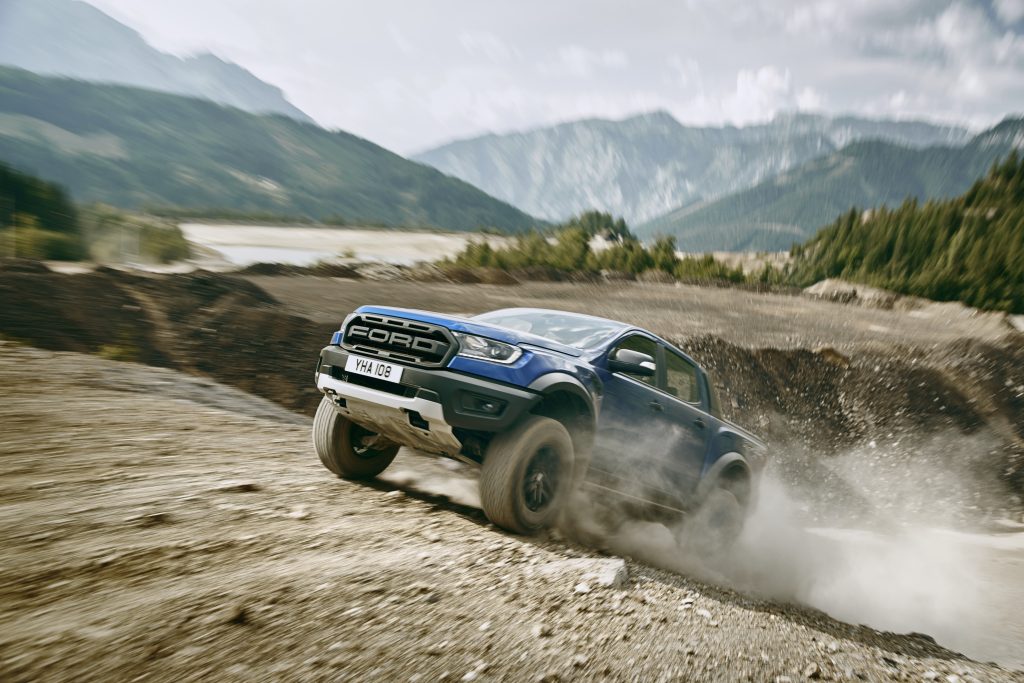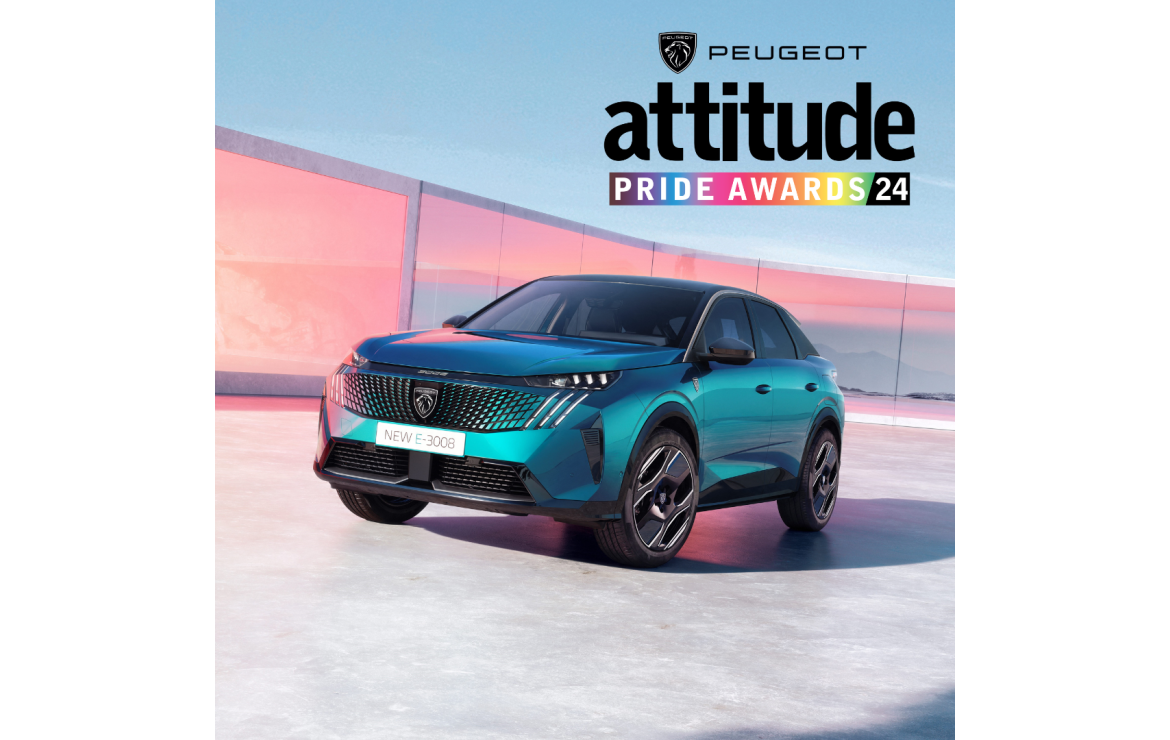The new Ford Ranger Raptor – the toughest and most high-performing version ever of Europe’s best-selling pick-up – is storming into Europe, with first deliveries expected mid-year.
Developed by Ford Performance for the true enthusiast off-roader, the first-ever Ranger Raptor is powered by a Bi-turbo version of Ford’s 2.0‑litre EcoBlue diesel engine that delivers 213 PS and 500 Nm of torque; and Ford’s new 10-speed automatic gearbox.
The commanding presence delivered by the ultimate Ranger’s imposing dimensions and extreme styling is supported by a unique Ford Performance chassis optimised for high-speed off-road driving and go-anywhere capability.
“Forget everything you think you know about pick-ups,” said Leo Roeks, Ford Performance Director, Europe. “Our new Ranger Raptor is a different breed – a thoroughbred desert racer and extreme lifestyle off-roader that can toil with the best of them in the harshest of working conditions.”
The Ford Ranger is Europe’s best-selling pick-up. Ford sold 13,600 units in the first quarter of 2019, an increase of 15 per cent compared with the same period the previous year.
Rugged yet refined
Built to withstand high-impact off-road events, Ranger Raptor’s unique, super-strong reinforced chassis frame uses high-strength, low-alloy steels to endure the punishment delivered by off-road racing.
Raptor’s race-bred suspension has been specifically crafted to tackle fearsome terrain at high-speed while remaining in complete control and comfort, using a 150 mm wider track and 51 mm taller ride height compared with the Ranger XLT.
FOX shock absorbers with Position Sensitive Damping provide higher damping forces at extremes for unparalleled off-road capability, and lower damping forces in more moderate conditions for a smoother ride on-road. Front damper travel is increased by 32 per cent, and rear travel by 18 per cent.
The high performance 2.5-inch (63.5 mm) diameter dampers are supported by aluminium control arms, with protruding shock absorber towers at the front. A bespoke new coilover rear suspension arrangement features an integrated Watt’s linkage that allows the axle to move up and down with very little lateral movement.
Front braking is performed by twin-piston front callipers, increased in piston diameter by more than 20 per cent compared with the standard Ranger pick-up to 51 mm, and 332 mm by 32 mm ventilated discs. Rear braking performance is also enhanced with a 54 mm diameter rear calliper, and 332 mm by 24 mm ventilated discs.
All-terrain BF Goodrich 285/70 R17 tyres have been specially developed for the Ranger Raptor. The 33-inch (838 mm) by 11-inch (285 mm) tyres offer a tough sidewall to take on the most formidable environments with confidence, and an aggressive off-road tread pattern that provides an iron grip in wet, mud, sand and snow conditions.
“The standout experience of the Ranger Raptor, hands down, is how far you can push it off-road and still ride like a millionaire on-road,” said Damien Ross, chief program engineer, Ranger Raptor, Ford Motor Company. “Everything about the Ranger Raptor builds on the already outstanding sophisticated feel and functional capability of the Ranger, and then goes further. From a driving dynamic fun standpoint, it is really an exceptionally special vehicle.”
The unique chassis design is combined with optimised off-road geometry that delivers 283 mm ground clearance and 850 mm wading depth. A 32.5-degree approach angle, and ramp-over and departure angles of 24 degrees, provide impressive go-anywhere capability.
Ranger Raptor also features unique underbody protection to deflect off-road obstacles. The new bash plate is made from 2.3 mm thickness high-strength steel – more than 60 per cent thicker than the standard bash plate – in addition to the Ranger’s standard engine and transfer case under-shields.
Tuned for all terrains
Ranger Raptor enables drivers to select from six Terrain Management System modes to tackle a wide range of terrain and driving scenarios, including:
- Normal mode – emphasising comfort, fuel economy and driveability
- Sport mode – more responsive for spirited on-road driving
- Grass/Gravel/Snow mode – designed to inspire safe and confident driving on off-road slippery and uneven surfaces
- Mud/Sand mode – tuning vehicle responses for optimum traction and momentum in deep, deformable surfaces like loose sand and mud
- Rock mode – specifically for low-speed rocky terrain where smooth controllability is key
- Baja mode – tuning responses for high-speed off-road performance, just like drivers need in the famous Baja desert rally
Ford engineers extensively tested the new Ranger Raptor’s powerful Bi-turbo 2.0-litre EcoBlue and 10‑speed automatic powertrain to prove durability in the most fatiguing conditions, including running the high-pressure and low-pressure turbochargers until they glowed red-hot for 200 hours non-stop. The two turbochargers work in series at lower engine rpms for enhanced torque and responsiveness. At higher rpm, the larger low-pressure turbocharger delivers peak power.
Ford’s 10-speed automatic transmission is shared with the F-150 Raptor and has been created with high-strength steel, aluminium alloys and composites to optimise durability and weight. The wider ratio-span results in better acceleration, responsiveness and contributes to 8.9 l/100 km fuel-efficiency and 233 g/km CO2 emissions.* Real-time adaptive shift-scheduling algorithms help ensure the right gear is selected at the right time. A unique transmission calibration also includes a Live in Drive function, with paddle shifters always available for manual gear selection override.
Driver assistance and safety technologies that boost confidence for drivers facing unknown off-road challenges or demanding working environments include an enhanced version of Ford Stability Control incorporating Roll Mitigation Function and Electronic Stability Control; Trailer Sway Control; Hill Start Assist; Hill Descent Control and Load Adaptive Control.
Practical technology at hand
Sophisticated technologies designed to make the new Ranger Raptor comfortable and convenient on- or off-road include Ford’s SYNC 3 communications and entertainment system, which enables drivers to control audio, navigation and connected smartphones using simple, conversational voice commands. The system delivers Apple CarPlay and Android Auto™ at no extra cost, and features SYNC AppLink for voice-activation of a range of smartphone apps.
The system’s central 8-inch colour touchscreen can be operated with pinch and swipe gestures, and features sat-nav technology that comes into its own when off-roading in remote locations, even offering a “breadcrumb” feature to leave a trail when exploring unchartered areas. FordPass Connect embedded modem technology delivers connectivity on the move.
Impressive in form and function
Available in Ford Performance Blue, Colorado Red, Shadow Black, Frozen White and Conquer Grey colours with contrasting Dyno Grey accents, the new Ranger Raptor’s aggressive design is driven by performance and functionality.
A dramatic new grille inspired by the world’s first factory-built high performance off-road truck – the Ford F‑150 Raptor – dominates the space between the xenon high-intensity discharge headlights and above a frame mounted front-bumper system. Offering desert durability performance, the front bumper also includes new LED fog lamps with functional air-curtain ducts that improve air flow around the body.
Striking, flared composite front fenders are to designed to shrug off damage from off-road usage, and allow for longer suspension travel and oversized tyres. The side step boards are designed specifically to prevent rock spray from hitting the rear of the truck, and feature drain points for sand, mud and snow.
The Ranger Raptor remains a true workhorse. A modified rear bumper features an integrated tow bar with 2,500 kg capacity. Two front recovery hooks are able to shift up to 4,635 kg, and two at the rear are rated 3,863 kg. A 1,560 mm by 1,575 mm load tray has been designed with the weekend explorer in mind, able to accommodate dirt bikes or jet-skis, in addition to work tools and supplies. For convenient access a Lift Assist Tailgate uses a new torsion rod assembly to give the owner a 66 per cent reduction in the force required to close it.
Ford Performance DNA is present throughout the interior, which delivers quality craftsmanship, harmonious colours and durable materials for driving scenarios from the high street to high altitude. The premium leather and suede bolstered seats are specially designed for enhanced grip and off-road high-speed support with a dual-firmness cushion for ultimate comfort.
Blue stitching and leather accents feature throughout. Lightweight, racing-style magnesium paddle shifters for crisp gear changes are easily accessible near the perforated leather hand grips of the bespoke steering wheel, which uses an on-centre marker to help drivers keep track of wheel position off-road, and is embossed with the Raptor logo.
“The new Ranger Raptor delivers all the tools a thrill-seeker could ask for,” Roeks said. “Like a motocross bike, snowmobile and an ATV in one – it’s the ultimate adventure pick-up.”
Desert racing heritage
The Ford Ranger Raptor’s Baja mode is a reference to the Baja 1000; a gruelling endurance rally through Mexico’s Baja California Peninsula and one of the most prestigious off-road events in the world.
The new Ranger Raptor remains true to the DNA of its predecessor, the original Ford F-150 SVT Raptor, which came third in the Baja 1000 in 2008, before going on sale to customers in the U.S. in 2010.
Like its predecessor and the latest generation Ford F-150 Raptor, the Ranger Raptor was torture-tested in the challenging desert landscapes around Borrego Springs in the U.S.
# # #
Android and Android Auto are trademarks of Google Inc.
*The declared fuel/energy consumptions, CO2 emissions and electric range are measured according to the technical requirements and specifications of the European Regulations (EC) 715/2007 and (EC) 692/2008 as last amended. Fuel consumption and CO2 emissions are specified for a vehicle variant and not for a single car. The applied standard test procedure enables comparison between different vehicle types and different manufacturers. In addition to the fuel-efficiency of a car, driving behaviour as well as other non-technical factors play a role in determining a car’s fuel/energy consumption, CO2 emissions and electric range. CO2 is the main greenhouse gas responsible for global warming.
Since 1 September 2017, certain new vehicles are being type-approved using the World Harmonised Light Vehicle Test Procedure (WLTP) according to (EU) 2017/1151 as last amended, which is a new, more realistic test procedure for measuring fuel consumption and CO2 emissions. Since 1 September 2018 the WLTP has begun replacing the New European Drive Cycle (NEDC), which is the outgoing test procedure. During NEDC Phase-out, WLTP fuel consumption and CO2 emissions are being correlated back to NEDC. There will be some variance to the previous fuel economy and emissions as some elements of the tests have altered i.e., the same car might have different fuel consumption and CO2 emissions.





